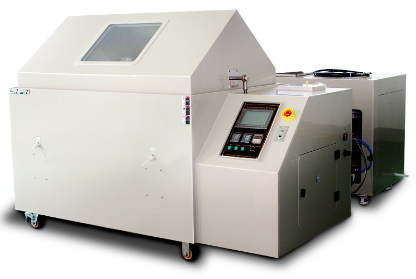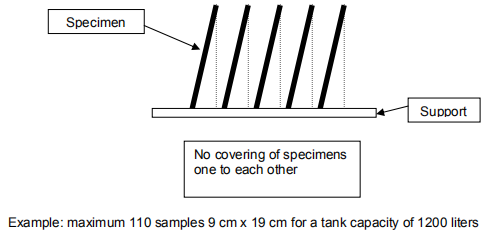Climatic chambers for standard D17 2028 Corrosion test by automatic change of phases or salt spray, drying and humidity
This standard method is intended to describe a cycle of the ECC1 corrosion test, associated equipment and the verifications which are necessary to ensure compliance of the test. This method can be applied to testing laboratory samples, to parts or samples of vehicle parts. This standard needs a climatic chamber--cyclic salt spray test chamber.
The test pieces and/ or parts are placed in an automatic corrosion chamber where they are exposed to a succession of attacks in controlled atmospheres, simulating natural conditions of pollution by chloride ions, exposed to warm and moist when warm and dry atmospheres.
1. Phase of pollution by pulverization of a saline spray
The spray comes and pollutes specimens and/ or parts by gravity.
The machine should control the homogeneity of spray and obtain a pluviometry of 5ml±1ml/h at any point of effective volume in an empty or loaded chamber ( for a collector of 10cm diameter).
The air pressure is between 0.7bar and 1.6bar.
Moreover, the chamber shall be equipped with a system to ensure that the salt spray took place in a corresponding way, for instance a system to record the flow and cumulative consumption of saline solution.
2. Phase of humidity and controlled drying
The accepted tolerance is ±3% relative humidity, except for the relative humidity of 20% where the tolerance accepted is ±5%. These values must be recorded and stored for ongoing verification of specifications.
3. Flushing phase
This air flushing phase makes it possible the elimination of salt spray present in the chamber at the end of the salt spray phase.
4. Wall rinsing phase
This phase of rinsing the walls of the chamber with demineralized water removes salts deposited during the salt spray phase and thus avoids the accumulation and thus the concentration of salts during the cycles, influencing the profile in relative humidity. It is done by rinsing ramp located on the periphery of the tank.
5. Chamber environment

We advise to have a tank for preparation of the saline solution and another for usage.
The tank conception should be such that its cleaning can be carried out easily. Improper cleaning causes heavy flow decreases and thus affects the final quality of the test.
The tank and the pipes carrying the saline solution must be made with an insert substance to the saline solution(eg PVC). The tank and piping used to convey the saline solution must be opaque in order to prevent the growth of bacteria and the formation of a algae during the test, which would lead to the deterioration of the saline solution. If the preparation tank is equipped with a stirrer, it should be insert to the saline solution(eg stainless steel stirrer covered with a plastic sheath).
The tank must be fitted at its output of a filter to prevent any possible pollution of the circuit and therefore the risk of clogging sprayers.
Air entering he machine must first be de-oiled and filtered to avoid the presence of particles. This air is described as follows:
Dry air filtered exempt of water, oil
Metal particles or organic dirt below 0.2 mg/m² and diameter of less than 5 µm.
Water supply from saturator and the humidifier should be de-ionised and have a conductivity ≤ to 5 micro-siemens(resistance of minimum of 200 kΩ). The saturator temperature should be between 45℃ and 50℃ during salt spray, depending on the actual pressure of the compressed air.
The supports for specimens shall be made in full unalterable material under test conditions. Except in individual cases and clearly identified, the supports must allow to incline the pieces or parts of pieces by 20°±5° with respect to the vertical.
They must be designed to avoid the areas of water retention and hence the accumulation of salt.
Moreover, it is very important that these materials are carried out so as not to obstruct flow of air in the chamber, it is necessary that all parts of the supports are hollowed out as much as possible.
Any runoff on the support(such as from water retention on the pipes feeding solution and air, from rinsing the walls, etc. ) is prohibited.
It is requested no covering of specimens or overloading them in the chamber in order to guarantee a free flow of air and therefore guarantee a regulation of humidity and a volume of saline solution collected on each specimen in accordance with the requirements.

Sodium chloride (purity of sodium chloride 99.8%). Sodium chloride should not contain, in the anhydrous state, more than 0.2% of impurities in total, or more than 0.1% sodium iodide. It should be free of copper and nickel(less than 10mg/kg for each of the two elements).
It is preferable to prepare a new solution before each test and not to prepare more than 50 liters at a time for each chamber to avoid any changes in the meantime.
The sprayed solution during this test is a solution of 1% (±0.05%) NaCl ( 10g/l), pH4 (±0.2) (Density between 1.0065 and 1.0075). The solution is measured at 23±2℃.
The preparation of the solution is carried out following these steps:
Prepare the quantity of demineralized water(≤conductivity to 5 μ siemens) desired,
Add the calculated quantity of salt, the final solution is to be 1±0.05% de NaCl (10±0.5g/l),
Shake the solution
When the salt has dissolved, check the salt concentration of the solution and then adjust the PH of the solution to the value of 4.0±0.2 with sulfuric acid 1 N.
For more details, please feel free to contact sales@lenpure.com
Please visit www.lenpure.com











